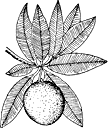View crop
View crop Data sheet EcoPortManilkara achras
 |
|
| Notes |
|---|
| BRIEF DESCRIPTION A much branched, slow growing, evergreen, small to medium sized tree. Under cultivation the tree usually reaches 9-20 m in height and up to 50 cm in diameter. As a forest tree it can attain heights of 30-38 m with diameters of up to 150 cm. USES The fruit is eaten fresh, used to flavor ice cream, and made into syrup and jam. A milky latex from the bark is used in chewing gum. The fine, hard wood is used to make various wooden articles. The tree is mentioned as a useful agroforestry species. KILLING T Young trees may be killed by -1°C, but older trees can survive temperatures as low as -3 to -4.5°C for some hours. GROWING PERIOD Perennial. The tree begins to fruit 3-4 years after planting and yields increase up to 25-30 years. The fruit takes about 120 days to mature from flowering. Latex are obtained by tapping the trunk once every 2-3 years. COMMON NAMES Sapodilla, Chicle, Chicle tree, Dilly, Naseberry, Marmalade plum, Nispero, Tree tomato, Small sapote, Sawo, Sapotille, Nefle d'Amerique, Zapotillo, Chicozapote, Nispero, Chico, Chicopote, Chicku, Chico, Sapote, Sapote amarillo, Sapota, Chika, Sapoti, Talalog, Sapote a gomme, Sapodilla plum, Surinam medlar, Breiapfel, Sapotaapfel, Nisporo de Nicaragua, Zapote de abeja, Zapote de chicle, Bully tree, Sapotilha, Nisperd, Chiku, Ciko, La-mut-farang. FURTHER INF Scientific synonyms: M. zapota, M. zapotilla, Achras sapota, Ackras Cosaguigo, A. zapodilla, Nispero achras, Sapota achras, Calocarpum spp, Lucuma nervosa. Sapodilla is a native of Central America. It thrives near the seashore in the humid tropical lowlands below 500-900 m, but can be found up to 2500 m in elevation and can also be grown in some subtropical regions. It does not like a hot dry summer, but is quit drought resistant. The tree is salt sensitive, though it withstands salt sprays close to the sea and can be grafted on rootstocks of M. hexandra to allow fruit production on saline land. With its tough branches the tree tolerates strong winds, but on sandy soils the tree can be uprooted by the wind. A good tree may yield up to 2500-3000 fruits per year or about 250-300 kg. Annual yields per ha of 20-30 t have been reported in Florida, 20-25 t in the Philippines and 20-80 t in India. | Sources |
| SOURCES (M. achras (Mill.) Fosberg) Nagy S 1980 pp 69 Hackett C 1982 pp 143 [FER, PHO, DEP, PH, TEXT, TEMP] Roecklein J 1987 pp 249 [USE, TEXT, KTMP, LIG] Duke J 1975 pp 20 [PH, RAIN, TEMP] Williams C 1979a pp 138-139 [RAIN, FER, DRA, TEXT] Popenoe W 1974 pp 334 [KTMP, FER, TEXT, DEP] Purseglove J 1974 pp 647 [USE] Samson J 1982 pp 13 Samson J 1986 pp 302-304 [USE, DRA, PH, SAL, FER] Nair P 1984 pp 25 [RAIN, TEMP, TEXT, DEP, DRA, PH, USE] Hensleigh T 1988 pp 214-215 [FER, DRA, TEXT, DEP, SAL, PH, TEMP, KTMP, RAIN, USE] Lotschert W 1983 pp 225 Vandenput R 1981 pp 1050 Atta M 1990 pp 61 Goodin J 1990 pp 32 Singh R 1969 pp 120-123 [TEMP, KTMP, USE, TEXT, DRA, SAL] Verheij E 1991 pp 220-223 [USE, KTMP, SAL, FER, DRA, TEXT] |